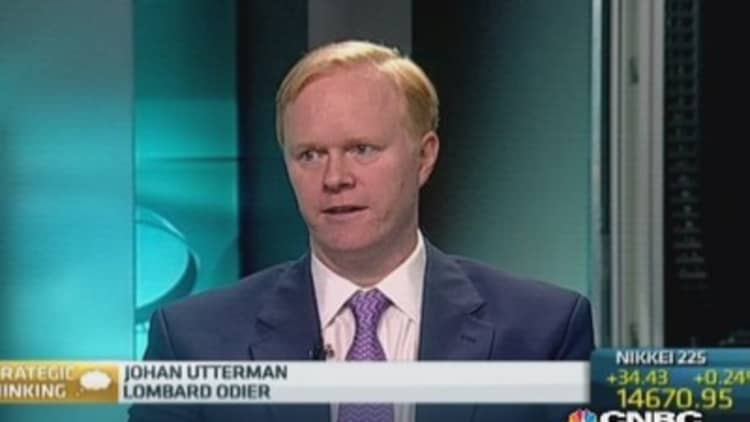The U.S. population is getting grayer. Learning how to profit from an aging demographic can be a minor form of consolation set against time's merciless tick-tock.
Playing population trends is a foundation for many investable themes—for example, the population boom in the developing world and the rise of its consumer class. The so-called gray wave in the U.S. will continue to grow, too. Currently, 13 percent of the U.S. population is 65 or older, according to U.S. Census data. By 2030, that number will rise to 18 percent of the nation as 10,000 baby boomers retire every day up until then. They'll need new knee replacements, along with an array of new and old drugs as they age.
Investors will benefit from this graying of America, and exchange-traded funds are a diversified way to target the trends associated with an aging demographic.

Neena Mishra, director of ETF research at Zacks Investment Research, pointed to pharmaceutical ETFs. They're slated to prosper as demand for drugs grows in the U.S., as well as in emerging markets.
One reason Mishra likes pharmaceutical ETFs is because they have a more stable profile than biotech ETFs, while offering growth potential.
Mishra recommends the PowerShares Dynamic Pharmaceuticals Portfolio ETF (PJP), the largest in the group, with $1.13 billion in assets. Big U.S. drug companies, including Johnson & Johnson, Merck and Eli Lilly, are among the top holdings, but there are also some biotech firms, including Biogen Idec and Amgen.
"This ETF isn't plain vanilla," Mishra said. "It selects and weighs companies based on targeted criteria, like earnings." The strategy has worked well, she said, noting that the ETF is up 12 percent so far this year and 40 percent in the past one-year period.
Read MoreDebating the value of wimpy ETFs
SPDR S&P Pharmaceuticals ETF (XPH) is another Mishra pick. It has a mix of big, medium and small pharma companies. Its top holdings include Questcor Pharmaceuticals, Allergan and Akorn. "Most of the holdings are known companies, though," Mishra said. This ETF also has a lower expense ratio than the PowerShares ETF—0.35 percent vs. 0.63 percent for Powershares Dynamic Pharmaceuticals. And it has performed slightly better this year, up 15 percent.
How many people will need knee replacements in the next 10 years alone? The explosion is huge.Gary Gordonfinancial advisor and president of Pacific Park Financial
Morningstar fund analyst Robert Goldsborough said diversified health-care ETFs are a more diversified way to gain exposure to drug companies. The Health Care SPDR (XLV), which has near-$10 billion in assets, has drug companies Johnson & Johnson, Pfizer and Merck among its top holdings, along with insurance plan providers, like UnitedHealth. Goldsborough also highlighted the Vanguard Health Care ETF (VHT), which also has big drug company holdings.
These funds are inexpensive and cover every part of the health-care sector, too, including biotech, he said. XLV has an expense ratio of 0.16 percent; Vanguard's VHT has an expense ratio of 0.14 percent. Returns for these ETFs are not as strong as for the more concentrated bets—not surprising, given the greater diversification across health-care stocks. XLV is up 9 percent year-to-date and 24 percent in the past one-year period, while VHT has slightly outperformed its peers in the past year with a return of 26 percent—at a slightly lower management fee.
Read MoreHave an investing idea? Build your own theme-based ETF
For a more concentrated health-care bet, Goldsborough likes biotech ETFs.
"There's lots of growth and mergers and acquisitions in this niche," he said. IShares Nasdaq Biotechnology Index ETF (IBB), which has more than $5 billion in assets, is worth considering, he said. It owns big biotech stocks, including Amgen and Biogen Idec, but "smaller upstarts sit shoulder-to-shoulder with big companies in this ETF," Goldborough explained.
SPDR S&P Biotech ETF (XBI) is a similar ETF.
IBB has an expense ratio of 0.48 percent; the SPDR biotech ETF has an expense ratio of 0.35 percent. IBB is up 10 percent year-to-date and 42 percent over the past one year, matching returns of the pharmaceutical ETFs. XBI has been the winner in recent history, up near-18 percent this year and 44 percent in 2013—at its lower expense ratio of 35 basis points.
Biotechnology stocks have been hit hard in the past three months, "but there's a bright future for biotech, since the world needs innovative therapies," Goldsborough said, adding that he sees the biotech setback as only temporary.
Banking on knee replacements
To avoid the high-profile, high-risk biotech sector, Gary Gordon, president of Ladera Ranch, California-based Pacific Park Financial, recommends lesser-known, cheaper sectors, like medical devices. The only downside: There is just one ETF offering—the iShares US Medical Devices ETF (IHI)—which holds medical device companies, including Medtronic, but also has big pharma company Abbott Laboratories among its top holdings.
The reason for owning this ETF is clear, as far as Gordon is concerned. "How many people will need knee replacements in the next 10 years alone?" Gordon said. "The explosion is huge."
Read MoreHow the ground is shifting in the ETF industry
IHI has an expense ratio of 0.46 percent. Year-to-date it is up 10 percent and close to 29 percent over the past one year—though that could be considered pricey for an ETF that has an expense ratio three times that of the broadly-based health-care ETFs with a similar recent performance profile.
Gordon also likes bond ETFs as people age and pursue yields, and in particular, bond ETFs that are held to a targeted maturity date. "Bond ETFs that are held to maturity offer diversified bond exposure, like a fund, as well as a fixed maturity date, like a single debt instrument," he said. "Diversification removes the risk of a single issue collapsing, while the fact that the investments will reach maturity secures the goal of an income stream."
Gordon uses ETFs from the Guggenheim BulletShares series as well as from the iShares held-to-maturity ETF series, such as the iShares 2019 AMT-Free Muni Term ETF (MUAH). Gordon also likes select bond ETFs from the traditional fixed-income space including SPDR Nuveen Barclays Capital Municipal Bond ETF (TFI).
Lastly, consumer discretionary ETFs are worth looking into, said Mohit Bajaj, director of ETF and portfolio trading services at New York City-based WallachBeth Capital.
"As people age, they have more disposable income," Bajaj said. PowerShares Dynamic Leisure & Entertainment (PEJ) holds big hotels, restaurants and travel company stocks. Bajaj also likes Market Vectors Gaming (BJK), which holds big gaming stocks, along with hotels. "It's the main gaming ETF out there," he said.
PEJ has been the less volatile of the two consumer ETF plays—flat this year and up near-20 percent over the past one year—while BJK is down 9 percent this year, though it has returned 17 percent over the past one-year period. Net expense ratios are similar: 0.63 for PEJ and 0.65 percent for BJK. Las Vegas Sands—BJK's top holding—is the only gaming company among PEJ's top 10 stocks.
Even though aging is a sure thing, investing in the gray wave is uncertain and faces a short-term headwind that all stocks are contending with. "With the stock market at all-time highs, you can't just plug into a theme and everything's fine," Gordon said, though he does believe that over the longer run, some ETFs will benefit.
CORRECTION: This version corrects that the SPDR Nuveen Barclays Capital Municipal Bond ETF is a traditional fixed-income exchange-traded fund.
—By Constance Gustke, special to CNBC.com






